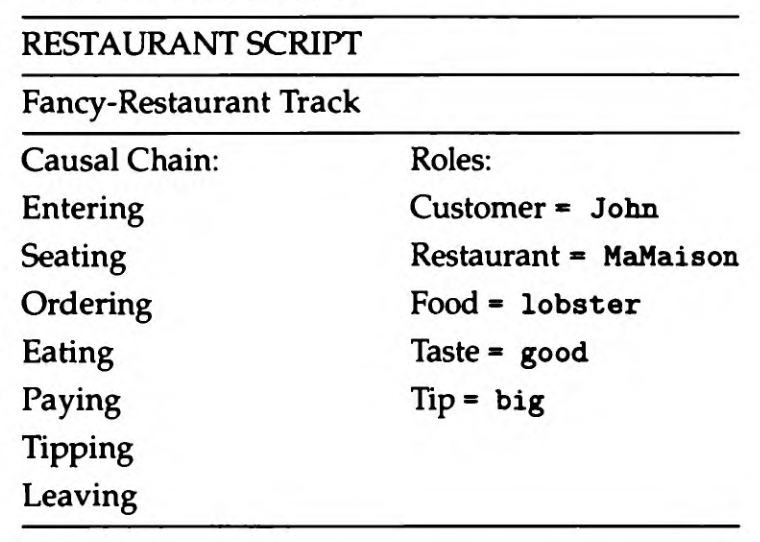Scripts also support a computational theory, similar in spirit to Frames in artificial intelligence (Minsky 1981). Both are based on the general idea of Schemas as a basis for mental representation (see e.g. Arbib 1989; Brewer and Nakamura 1984; Bartlett 1932; Bobrow and Norman 1975; Rumelhart 1980).
According to Schema Theory, people organize knowledge about familiar objects, situations, and procedures in terms of prototypes, or schemas. A Schema consists of a representation for common knowledge that is shared by all instances, and a number of Slots that take on different values for different instances.
For example, a schema (Frame) for a room consists of the common structure (walls, floor, ceiling, door), and slots for size, shape, furniture, and so on (Rumelhart et al. 1986d). A schema (script) for a Restaurant Visit specifies the common events (such as entering, seating, ordering, eating) and slots for the customer, restaurant, food, amount of the tip, and so on.
In symbolic natural language processing (NLP) a script is represented as a causal chain of events with a number of open roles (Culling ford 1978; Dejong 1979; Dyer et al. 1987; Schank and Abelson 1977; table 2.1). Different variations of the script are called Tracks. For example, there is a fancy-restaurant track, fast-food track, and a coffee-shop track for the restaurant script, each with slightly different events.
Applying scriptal knowledge to a story requires identifying the relevant script and filling in its roles with the actual constituents of the story.

Table 2.1 Representation of a script-based story as a causal chain and role bindings. This particular instantiation is a simplified version of the fancy-restaurant script, where only the main events have been listed.
~
MIIKKULAINEN, Risto, 1993. Subsymbolic natural language processing: an integrated model of scripts, lexicon, and memory. Cambridge, Mass: MIT Press. Neural network modeling and connectionism. ISBN 978-0-262-13290-9, p. 15–16.
Perception depends on context. From one point of view the way seems impassible. From another point of view the path is revealed. Each view is limited by its own frame. Changing frames changes perception. Changing perception changes both understanding and action.
But there’s more to this story. We’ll talk about it a bit more formally in the next section. But the basic point is that so far we’ve just talked about picking reference frames in a “spacetime causal graph”. But ultimately we have to consider the whole multiway graph of all possible sequences of update events. And then **we have to figure out how an [[observer] can set up some kind of reference frame to give them a perception of what’s going on.**
Kant first introduced the concept of schema. It is the internal landscape that we use to interpret the world around us. How we make sense of our perceptions.
# The Shape of our Schema Guides the Stories we Tell
We accumulate stories with meanings unique to our human sapience. We begin with a schema, instantiate graph fragments within that schema, and then assemble fragments to discover new stories where fragments touch.
We construct a schema from type information in nodes and relations.
Small discovery of the day: Algorithmic markup in one plugin interprets the meaning of the remainder of the page which should be designed with this cooperation in mind.